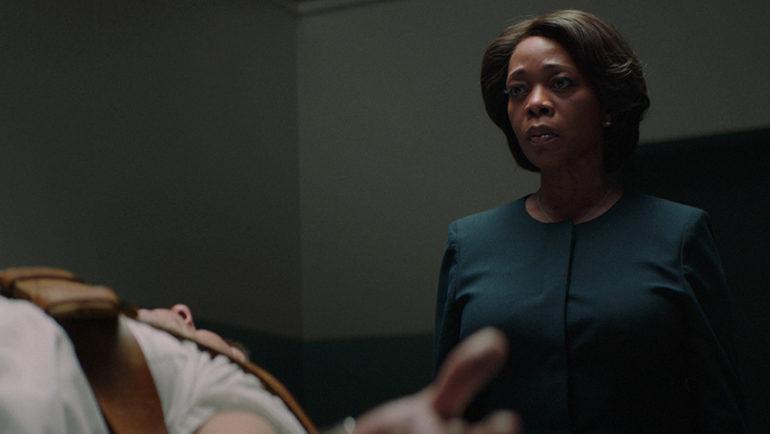‘The Pacing Was a Character in the Film’: Editor Phyllis Housen on the Heartstopping Tension of ‘Clemency’
By Jazz Tangcay
LOS ANGELES (Variety.com) – In director Chinonye Chukwu’s movie “Clemency,” prison warden Bernadine Williams (played by Alfre Woodard) has been doing this job for years. Like clockwork. She has seen death and executions far too many times to let it jar her. Her face is stoic as she pulls the curtain around. Except, this time, this execution that’s just another routine death goes wrong.
And it spirals from there. As the title suggests, there’s one more case, one more man on death row Anthony Woods (Aldis Hodge) who claims he’s been wrongly accused. Meanwhile, Bernadine is unraveling. The deaths have been getting to her and have taken an emotional toll on her.
Her walk down the prison hallway gets heavier, the camera stays on her face for long periods of time.
Editor Phyllis Houson describes the pacing of the film as its own character. “Someone described it as “excruciating” and I took that as a compliment,” she says. “It was really about trying to get to feel like what it felt like to be in a prison on a daily basis.”
Chukwu and Houson worked together wanting to add a rhythm to the day, so they added in sounds of beating hearts, ticking clocks and the monitors.
In this “Framing The Scene,” Houson breaks down the key opening scene of the film and how important it was to get that editing right. In contrast, she also examines the film’s ending as a bookend and how important it was to slow the pacing right down.
Getting The Opening Scene Right:
That was crazy. I watch it now, and I can’t believe it. In terms of editing, it was a house of cards. We had to find all these pieces. We wanted to show how everything during the execution process is based on this ritual. It’s going as planned. Bernadine brings over the microphone; she brings the curtain across and then all of a sudden, everything goes wrong and so we start cutting faster and moving faster.
We created that chaos, by finding pieces of footage that are more askew. We’re moving around the room and using more handheld scenes. The doctor moving around the body, not being able to get a vein. The rubber is pulled tighter, and you’re not breathing. They find one and then it just goes off the track from there.
I don’t know if it was the first scene I cut, but it was certainly the big set-piece. With those scenes, you find structure and you go to something else. You cut those scenes over the month, and you’re even revisiting them. Things like that, you are always tweaking before lock picture.
The film’s ending [SPOILERS]:
The final big shot was something Chinoye really had in mind. It was tough to leave it there. When we first started working on that scene, that medium shot of Bernadine would go on forever. I said, “You can’t do this to an audience.” She said to “Just leave it.” After a while, you get used to it.
When we were cutting the scene, we didn’t have any of the sound effects. I knew what was going to happen. I didn’t know when the heart was going to stop beating. I didn’t know when the machines were going to stop.
A lot of those sound effects came together down the road. That said, there were points when we were sound spotting and through movements of Bernadine’s face we’d say, “Oh that happened” or “This is where she registers that he’s gone.” It’s a bold move.
In order to get to that shot, we needed to slow right down. I’ve never cut anything like that in my life. It was almost the opposite of the first shot. The opening was all about rhythm and protocol and then everything falls apart.
For the shot at the end, we had to slow everything down to fall into that medium shot. It’s about 2 minutes and 20 seconds long.
My favorite shots are with Bernadine walking. When you’re editing, we refer to those shots as “shoe leather.” In editing, we always say, “Get rid of the shoe leather.” In this movie, we wanted to show how far away from the general population that death row was. In order to do that, we had to follow Bernadine down that hallway forever. You just hear her heels clacking. You really feel the size of the prison and the length of the prison.
As she continues, you see her gait change. The way she walked changed. One shoulder got lower. If you watch the walking scenes, you can feel the burden taking its toll.
The suicide attempt was also a favorite scene. It wasn’t a stunt person. We really needed it to feel like he was hitting his head really hard. It took a lot of work and tools. When you watch that in the theater and hear the audience respond, it’s like no other experience. What ensues after, the chaos and the guards come in.
Aldis Hodge yells, “I say when I die,” It’s so intense and it just ends in the hospital bed and she’s looking in through the window. The tone switches from such intensity to calm.

